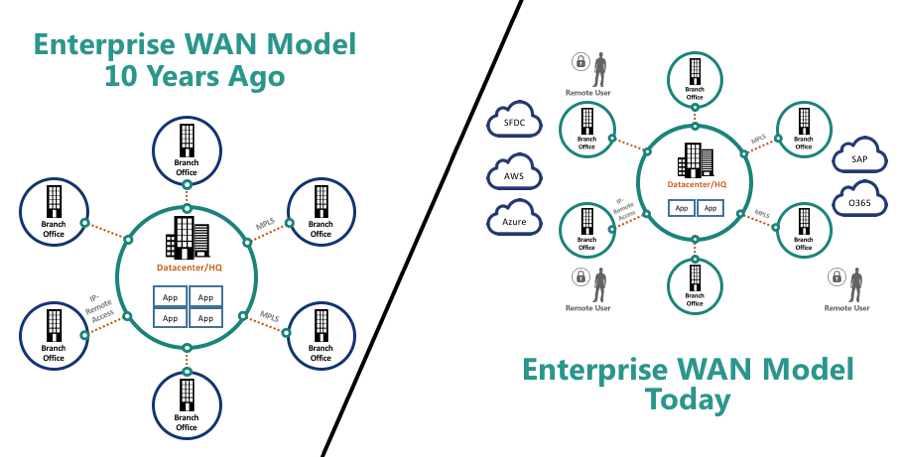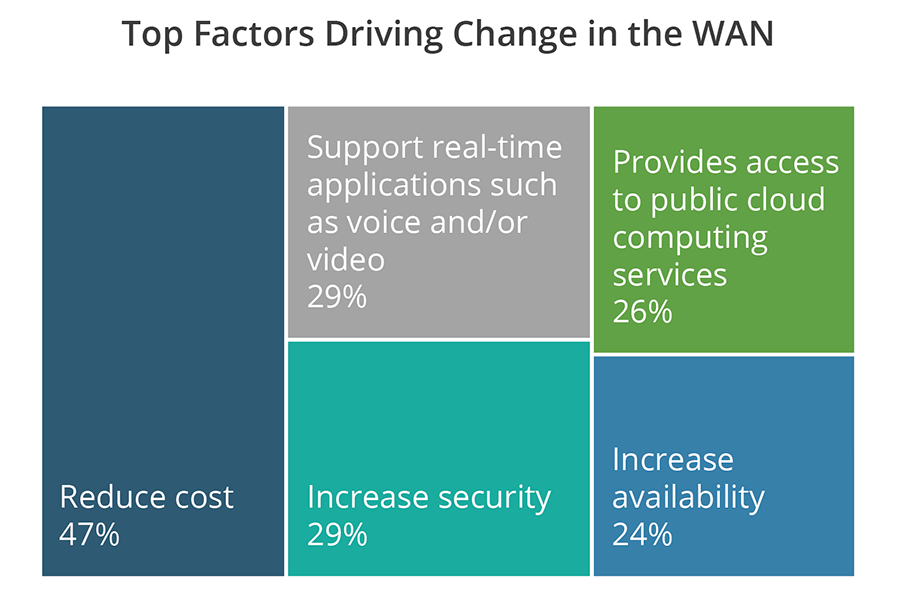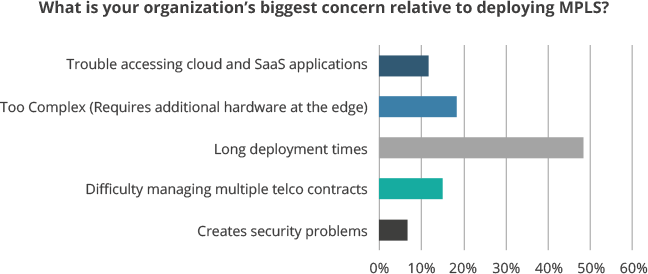MPLS Alternatives & MPLS Replacement That Meet Enterprise WAN needs

MPLS is entering its sunset, and yet telcos aren’t ready to let you go. Rather than see you invest a few more years in a legacy technology that needs to be retrofitted with WAN Optimization, SD-WAN, and more, we held a webinar to discuss your mpls alternatives.
We were joined by Jim Metzler, Founder and Vice President of Ashton, Metzler, and Associates, along with Yohan Beghein, System Integration Manager at Skullcandy, to discuss how network admins like you can optimize the enterprise WAN without turning back to MPLS.
Here are the key takeaways from the webinar. You can access the complete webinar here.
The Reality of Modern Networking & Enterprise WAN
One of the biggest concerns for any IT team can be summed up in one single image, as shown in the diagram above. The happy days of a simplified, traditional “hub and spoke” model of branch office connectivity (shown on the left) are, unfortunately, over. The current IT landscape is more complex than ever, and IT teams find themselves responsible for not just the users at branch offices, but also an influx of remote users, an eclectic mix of applications and delivery models (both on-premise and Cloud/SaaS applications), and myriad devices.
Metzler described how most of his clients are facing intensified global pressure from organizations whose business models now completely rely on IT to gain a competitive edge, capture new markets quickly, and provide customers with fast and reliable service. The CIOs are expected to deliver these results while dealing with a lack of IT resources and keeping costs low.
As the IT landscape becomes more complex and the cost and time taken to run and maintain the systems skyrockets, this snowballs into a mammoth task for the IT leaders and their teams.
It is then of little surprise that when Metzler polled the webinar attendees about the top factors that will drive changes in the enterprise WAN, a staggering 47% chose the “need to reduce cost” as a primary driver. An additional 29% chose “increasing security and improving performance for real time applications,” and 26% and 24% chose “better access to cloud” and “increasing availability” respectively.

Problems with MPLS
One of the fundamental problems in the enterprise WAN space today is that, while IT and business have undergone a 180-degree change in the last two decades, there has been negligible innovation in the networking fundamentals. As a result, 66% of IT executives today are not/or only moderately happy with their WAN architecture, as Metzler explained.
MPLS made a massive commercial debut in the early 2000s and became the gold standard for connectivity. The problem is that MPLS was not built to handle the cloud intensive, demanding workloads of today.
While MPLS did its fair bit in providing a reliable connectivity to global enterprises, it is clear now that it can hardly match up to the current connectivity demands.
For example, MPLS is slow to deploy, as it can take months or even years to set up a new link. The results of another poll during the webinar confirmed that this is a top concern for IT executives.

The poll also revealed that complexity and accessing cloud and SaaS applications were the second and third concerns on IT executives’ minds regarding MPLS. All of these concerns can be addressed by bypassing MPLS and using the public Internet, but the Internet cannot be trusted for critical enterprise traffic due to high latency, congestion, and security concerns.
In a world where most global organizations are adopting a cloud-first approach, MPLS is poised to become irrelevant soon. The reasons are manifold: few cloud/SaaS vendors have MPLS connectivity options and most MPLS vendors do not own cloud/SaaS vendor infrastructure or provide support for applications hosted in the cloud.
Most global companies today are feeling the pressure to find a suitable MPLS alternative and the Internet. What they need is an enterprise-grade connectivity solution that is intelligent, secure, quick to deploy, cloud-ready, and cost-effective.
Enterprise WAN Alternatives & Transformation: Skullcandy Case Study
To emphasize the importance of rethinking the WAN strategy and the benefits it can bring to the enterprise, Metzler then invited Yohan Beghein, System Integration Manager at Skullcandy to share a case study. Beghein discussed how Skullcandy, one of the global brand names for high-quality headphones, earphones, Bluetooth speakers, and related accessories, replaced their MPLS circuits with Aryaka’s global SD-WAN to connect offices in the United States, Canada, Germany, China, and Japan.
Beghien explained how Skullcandy was facing a challenge that many organizations across the world deal with: a spike in enterprise bandwidth requirements during the winter holiday season. The company was facing latency and application performance issues over MPLS in Germany, China, and Japan. Executive teams across different regions around the world could not collaborate effectively, as their telepresence solution was unable to keep up with the high latencies. Moreover, MPLS bandwidth was prohibitively expensive, and it took “forever” to scale up or down.
Skullcandy realized that they needed to move beyond the conventional solutions to a more flexible and reliable connectivity solution. By choosing a cloud-ready SD-WAN solution, Skullcandy could achieve up to 10x better application performance improvement, 93% data reduction across all applications, and about 40 Mbps peak bandwidth savings. Read the full Skullcandy case study to learn more.
Global SD-WAN Gains Traction as the MPLS Alternative
In recent years, SD-WAN emerged as the saving grace for most enterprises grappling with connectivity issues. However, not all SD-WANs can provide a complete replacement for MPLS.
When evaluating SD-WANs, you should look for a holistic solution that provides:
- Short deployment intervals
- Alternatives to MPLS pricing without sacrificing QoS or security
- End-to-end multi-layered security functionality
- Built-in WAN Optimization
- Secure, high-performance access to cloud applications and services
- End-to-end visibility and holistic control of the entire network
- Reduced complexity
- Managed service option
Metzler ended the webinar with a call to action for global enterprises struggling with connectivity issues: He suggested that companies need to start evaluating and write down the key challenges that might mean it’s time to re-evaluate the enterprise WAN. CIOs and IT leaders need to start weighing out alternative WAN solutions with a focus on whether their solution can truly respond to those key challenges and support their global operations. Most IT teams need a solution that can help them reduce or avoid complexity and relieve the team by providing support in the form of managed services.
To discover if global SD-WAN can address your connectivity challenges and transform your enterprise network, sign up for a proof of concept today.
Watch on-demand webinar on MPLS alternatives.
- Is MPLS dead? Understanding Need For mpls Network Technology
- What is MPLS network & How MPLS Works?
- 4 Reasons Why MPLS No Longer Serves Global Enterprises
- MPLS Network Pros and Cons
- SDWAN over MPLS: Is SD-WAN Better than MPLS?
- 5 Questions MPLS Providers Hope You Won’t Ask
- 3 Simple Ways for Choosing the Right MPLS Alternative
- The Slow Death of MPLS
- Can a Global SD-WAN Replace MPLS Connectivity?



